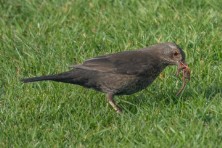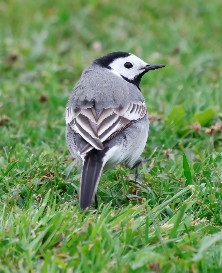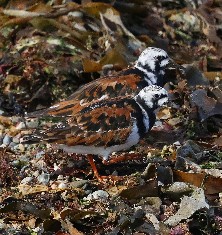April 2025
Bird Sightings
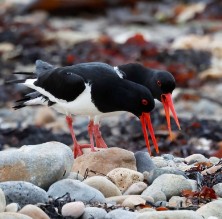
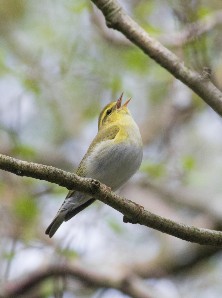
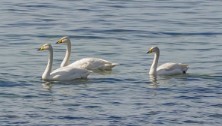
April is the month when spring migration gets underway, with arrivals and departures of birds, all seeking their best breeding territories. The weather was generally dry and calm. This April in comparison to last April was much drier with about a third of the rain of last April and warmer. The impact on migrating birds of the weather here and throughout their route is difficult to know. By the end of the month the bulk of the migrants had still to arrive. The benign weather seemed to have been less detrimental than the wind and rain of last April for breeding birds.
As reported at the end of March, the first Chiffchaff, Sand Martin, Swallow, Wheatear and Willow Warbler had arrived. Here are April “firsts” with the 2024 arrival date in brackets for comparison: House Martin 1 April (6 April), Sandwich Tern 4 April (3 April), White Wagtail 6 April (3 April), Cuckoo 7 April (17 April), Common Sandpiper 11 April (8 April), Whimbrel 13 April ( 18 April), Garden Warbler 18 April (20 May), Grasshopper Warbler 20 April (20 April), Sedge Warbler 20 April (28 April), Whitethroat 21 April (11 April), Tree Pipit 24 April ( 20 April), and Whinchat 24 April (21 April) but these were just the pioneers the bulk will arrive throughout April and May.
In April some of our wintering birds were still around, including three Redwing on Corriecravie Moor on 6th, twenty-five Fieldfare in Clauchan Glen also on 6th and a Purple Sandpiper in breeding plumage in Blackwaterfoot on 23rd. In the Shiskine Valley the migratory Greylag Geese left by mid-April while some of naturalised Greylag Geese population that hang about Lamlash Bay were on nests.
April is an ideal time for watching migration. These are a few examples: forty-five Whooper Swan flying over Sliddery on 1st, fifteen Golden Plover at Lagg Distillery on 2nd, ten White Wagtail at Clauchlands on 20th, twenty-one Great Northern Diver in Blackwaterfoot Bay on 24th, three hundred and eighty Pink-footed Geese flying over Cleats Shore on 24th, fifteen Sandwich Tern at Porta Buidhe on 26th, and twenty-eight Turnstone in breeding plumage in Blackwaterfoot on 27th. In addition, groups of migrating Whimbrel were reported including seventeen in Auchenhew Bay on 28th. One of these Whimbrel, A2, had been ringed on a southern Arran shore in 2017. Click here for more info.. Migration was also in evidence from the widespread reports received of Goldfinch and Siskin moving through people's gardens throughout the month. Tens of thousands of birds seem to be moving through the island at this time of year.
In April there were over one hundred and ten species recorded on Arran. One of these, Little Egret , again over-wintered on Arran. Last report received was one at Rubha Salach on 23rd. The solitary wandering Magpie that was reported at the end of March was last reported on 3 April in Brodick. Here is a further small selection from this list: a Kingfisher in Sannox Burn on 4 April, forty Gannet off Pirnmill on 9th, four Red-throated Diver calling off Pirnmill on 11th, a White-tailed Eagle being mobbed by gulls in Catacol Bay on 14th, two Arctic Skua in Sannox Bay on 21st, a Puffin in Sannox Bay on 24th and a report of a Hobby at Drumadoon Point has been passed to the Clyde Rarities committee for ratification. In addition, after no records last year it was heartening to have a report of a singing Wood Warbler in Corrie on 28th.
From a birding point of view, May should be an equally interesting month with the bulk of our summer visitors arriving including more species like Lesser Whitethroat, Spotted Flycatcher, Arctic Tern and hopefully, even Corncrake and Nightjar. Please continue to keep me posted on all summer visitors in your area. Your ongoing support is much appreciated.
Finally, spring is a great time to be birding, as most birds are getting on with the business of breeding. The business of breeding involves attracting a mate by song, courtship display and ritual, defining a territory, nest building, and generally establishing relationships. Please take a moment to report any signs of breeding birds to me. Already there have been reports of Blue Tit nest building, Skylark singing, Blackbird carrying food, Woodcock roding, Sandwich Tern courting while migrating, Hen Harrier sky-dancing, Lapwing displaying in a small number of areas, House Sparrow feeding young at garden feeders and on 30th there was a report of a female Mallard with twelve young at Silver Sands .
Please remember that under the Nature Conservation (Scotland) Act 2004 it is an offence to intentionally or recklessly damage or destroy the nest of any wild bird while it is being built or used. Take particular care on our shores and beaches and please keep your dogs on a lead at this time. They are a danger to all our ground nesting birds.
